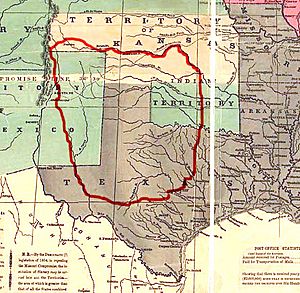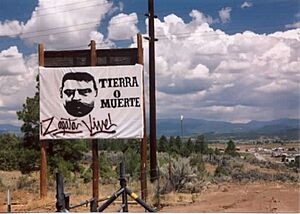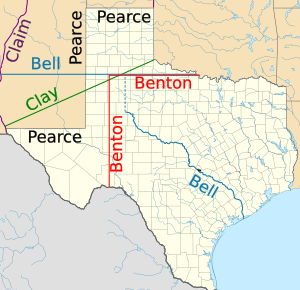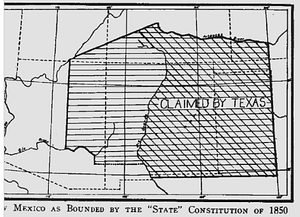History of New Mexico facts for kids
The history of New Mexico is about the many different groups of people who have lived in the area we now call New Mexico. People have been here for at least 11,000 years! The first people came from northern North America, crossing a land bridge from Siberia. They left behind amazing tools and buildings.
The first written stories about New Mexico came from Spanish explorers in the 1500s. They met the Pueblo people who lived in towns. Since then, Spain, Mexico, and the United States have all claimed this land.
New Mexico was a territory of the U.S. until 1912, when it became a state. It was a bit isolated and its economy relied on mining. In 1945, New Mexico became famous for starting the "atomic age" when the first nuclear weapons were made at Los Alamos. Today, New Mexico has a mix of Native Americans, Hispanics, and other groups.
Contents
Early Native American Life
People have lived in New Mexico for at least 11,000 years. The earliest known group was the Clovis culture, who were hunter-gatherers. They left behind campsites and stone tools.
Later, the Ancient Pueblo Peoples learned to farm. They built homes from stone or adobe bricks. Around 1000 AD, they had a "Golden Age" where their culture thrived. But changes in the climate made them move and adapt. From these people came the historic Pueblo people who lived along the main rivers like the Rio Grande and Pecos.
PREHISTORIC NEW MEXICANS
| CULTURE OR GROUP | TIME | LOCATION FOUND | IMPORTANT DEVELOPMENT |
|---|---|---|---|
| Clovis | 11,000 to 9200 BCE | Eastern Plains | Hunted big game |
| Folsom | 8200 BCE | American Southwest | Hunted big game |
| Desert Culture I | 6000 to 2000 BCE | American Southwest | Hunted small game; gathered seeds, nuts, and berries |
| Desert Culture II | 2000 to 500 BCE | American Southwest | Developed early gardening skills, baskets, and milling stones |
| Mogollon | 300 BCE to CE 1150 | West-central and southwestern New Mexico | Farmed crops, made pottery, and lived in pit-house villages |
| Anasazi: Basketmaker | CE 1 to 500 | Northwestern New Mexico | Used the Atlatl, gathered food, and made fine baskets |
| Modified Basketmaker | CE 500 to 700 | Northwestern New Mexico | Lived in pit house villages, used the manos and metate, learned pottery-making, and used bows and arrows |
| Developmental Pueblo | CE 700 to 1050 | Northwestern New Mexico | Built Adobe houses, used cotton cloth and infant cradleboards |
| Great Pueblo | CE 1050 to 1300 | Northwestern New Mexico (Chaco Canyon, Aztec) | Built multistory pueblos, practiced irrigation, and laid out road systems |
| Rio Grande Classic | CE 1300 to 1600 | West-central New Mexico, Rio Grande Valley, Pecos | Abandoned northwestern New Mexico sites, migrated to new areas of settlement, and changed building and pottery style |
Pueblo People and Spanish Explorers
The Pueblo people built amazing towns in the 1200s. They moved from pit houses to apartment-like buildings made of adobe. By 1050 AD, they had planned villages with large, terraced buildings. These villages were often built on high cliffs or mesas for protection.
One of the biggest villages was Pueblo Bonito in Chaco Canyon. It had about 700 rooms and may have housed 1000 people! The Pueblo people also used clever ways to bring water to their farms, like irrigation canals.
In the 1500s, the Spanish arrived. An explorer named Álvar Núñez Cabeza de Vaca heard stories about rich cities. Another explorer, Marcos de Niza, thought these were the mythical Seven Cities of Cíbola.
Francisco Vázquez de Coronado led a huge trip in 1540 to find these cities. He camped near a pueblo that is now Coronado National Memorial. But he found no gold. The Spanish treated the Pueblo and Athabaskan people badly. This made the native people hostile and made it hard for Spain to conquer New Mexico for a long time.
The largest Pueblo towns in New Mexico today are Zuñi, Santo Domingo, and Laguna. People in the Pueblos speak three different languages.
The Navajo and Apache are part of the larger Athabaskan language family. This family includes groups in Alaska and Canada.
These groups were not unified tribes in the way we think of them today. They lived in smaller, flexible groups because they moved around a lot. The Spanish called them by different names. The Navajo call themselves Diné, which means "the people."
Some experts believe the Apache were in New Mexico by the 1200s. Spanish records show they traded with the Pueblo people. Both the Navajo and Apache were nomadic, meaning they moved from place to place. They spoke similar languages.
From the 16th to the 19th centuries, these groups often raided Spanish and Pueblo settlements for food and supplies. By the early 1700s, the Spanish built forts to protect themselves from these raids.
Today, the Navajo Nation is the largest federally recognized tribe in the U.S. They live mostly in northwestern New Mexico and northeastern Arizona. The Mescalero Apache live east of the Rio Grande, and the Jicarilla Apache live west of it.
Spanish Rule in New Mexico
After Coronado's trip, Juan de Oñate came from Mexico in 1598. He brought 500 Spanish settlers and soldiers, and 7,000 animals. He started the first Spanish settlement in New Mexico, calling it San Juan de los Caballeros. This means "Saint John of the Knights."
Oñate also created El Camino Real de Tierra Adentro, "The Royal Road of the Interior Land." This 700-mile trail connected New Mexico to the rest of New Spain (Mexico). Oñate became the first governor of the new province of Santa Fe de Nuevo México.
The Native Americans at Acoma Pueblo fought back against the Spanish. Oñate's soldiers killed hundreds of Acoma people. They even punished men over 25 by cutting off one of their feet. The Spanish tried to convert the Pueblo people to Christianity, but the Pueblo often resisted.
Oñate's first capital was attacked by Apache (probably Navajo) groups. So, Governor Pedro de Peralta moved the capital and founded Santa Fe in 1610. Santa Fe is the oldest capital city in the United States.
Spanish rulers often exploited the native people for labor and resources. This led to many conflicts and raids with nomadic tribes like the Apache, Navajo, and Comanche.
Catholic missionaries also came with the Spanish. They often argued with the government over who controlled the native people. The native population suffered greatly from European diseases and harsh treatment. This unhappiness led to a major uprising.
Pueblo Revolt of 1680
Many Pueblo people were angry with the Spanish. The Spanish forced them to work and stopped them from practicing their traditional religion. A severe drought in the 1670s also caused famine and more raids from other tribes. Spanish soldiers couldn't protect the settlements well.
Because of these problems, the Pueblo people started returning to their old gods. This made the Spanish missionaries punish them even more. A Pueblo leader named Popé (or Po-pay) planned a big revolt.
Popé sent messages to all the Pueblos using knotted cords to count down the days. The revolt began on August 13, 1680. The Pueblo people drove the Spanish out of New Mexico, except for the very southern part. The Spanish set up a temporary capital in El Paso.
After the Spanish left, Popé ordered the Pueblo people to destroy anything Spanish, like crosses and Catholic images. He wanted them to go back to their old ways. He took control of the Governor's Palace and collected tribute from the Pueblos until he died in 1688.
However, the different Pueblo tribes, who spoke six different languages, started to argue among themselves. Raids from nomadic tribes and a seven-year drought also weakened them. In 1692, Diego de Vargas led Spanish forces back to Santa Fe. He promised peace if the Indians would surrender and return to Christianity. The Pueblo leaders agreed.
After the Spanish returned, they founded Albuquerque in 1706. They named it after the Duke of Albuquerque, a Spanish leader. The Spanish learned to give the Pueblos more land and respect their rights.
Spanish and Nomadic Tribes
From the beginning, Spanish settlers and Pueblo people faced problems with nomadic tribes like the Navajo, Apache, Ute, and Comanche. These tribes often raided settlements for animals, food, and captives.
Many of these tribes learned to ride horses, which they often took from Spanish ranches. The Navajo also became unique by raising sheep, which they had taken from the Spanish.
Comanche Power
After the Pueblo Revolt, the Comanche became the biggest threat to the Spanish. From the 1750s to the 1850s, the Comanche were very powerful in the Southwest. Their territory was called Comancheria. They used their military strength to get supplies and labor from Americans, Mexicans, and other Indian groups.
The Comanche were pure nomads and excellent horse riders. They were harder to catch than the Apache and Navajo. They both raided and traded with the New Mexicans. They were famous at the annual Taos trade fair, where they exchanged goods peacefully, sometimes right after raiding other places.
In 1778, the Comanche killed 127 Spanish settlers and Pueblo Indians. Spanish efforts to stop them often failed. But in 1779, a Spanish and Pueblo force led by Juan Bautista de Anza killed Cuerno Verde (Green Horn), a major Comanche war leader. After this, the Comanche made peace with New Mexico. They even joined the New Mexicans to fight their common enemy, the Apache.
This peace helped New Mexico grow. Settlements expanded eastward onto the Great Plains. The Comanche empire eventually collapsed due to diseases like smallpox and cholera, which greatly reduced their population. By 1875, they surrendered to the U.S. Government.
Mexican Rule
| Date | Spanish | Pueblo |
|---|---|---|
| 1600 | 700 | 80,000 |
| 1609 | 60 | ? |
| 1620 | 800 | 17,000 |
| 1638 | 800 | 40,000 |
| 1680 | 1,470 | 17,000 |
| 1749 | 4,353 | 10,658 |
| 1800 | 19,276 | 9,732 |
| 1820 | 28,436 | 9,923 |
| 1842 | 46,988 | 16,510 |
In 1821, Mexico gained independence from Spain. This change happened peacefully in New Mexico. Trade along the Santa Fe Trail opened up, bringing new people and goods from the United States.
Mexico became a federal republic, giving New Mexico a lot of local control as a territory. The new Mexican government tried to create a common identity for all its people, but in New Mexico, the social classes remained strong.
By the mid-1830s, Mexico's central government became weaker. New Mexico started to trade more with the United States. The Santa Fe Trail became a major trade route. New Mexico became a trading hub between the U.S., central Mexico, and California.
In 1845, there were rumors that Mexico planned to sell New Mexico to the U.S. New Mexicans were so distrustful of their government that they threatened to declare independence if this happened. They didn't know that war with the United States was coming soon.
Texas Claims New Mexico
The Republic of Texas broke away from Mexico in 1836. Texas claimed a large part of New Mexico, including Santa Fe, but they never actually controlled it. The only attempt to take the land was the Texan Santa Fe Expedition, which failed badly. The Texans were captured and marched to Mexico City.
United States Takes Control
Mexican–American War
In 1846, during the Mexican–American War, American General Stephen W. Kearny marched into Santa Fe without a fight. He set up a new government. Kearny promised that the U.S. would respect existing religious and legal claims. This promise became part of New Mexico's laws.
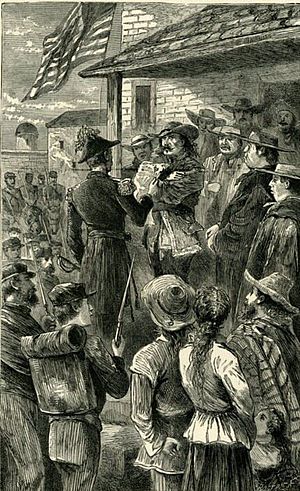
However, many New Mexicans didn't like the U.S. occupation. On January 19, 1847, rebels attacked and killed Governor Charles Bent and other American officials in the Taos Revolt. U.S. forces quickly put down the revolt, killing about 150 rebels. More executions followed. This showed the strong resistance to American rule.
Treaty of Guadalupe Hidalgo
In 1848, the Treaty of Guadalupe Hidalgo ended the war. Mexico gave up a huge amount of land, including what is now the American Southwest and California, to the United States. In return, the U.S. paid Mexico $15 million.
New Mexico became a U.S. territory. Most settlers chose to become U.S. citizens. The treaty promised to protect land ownership rights, but this led to many legal battles later on.
Becoming a U.S. Territory
The U.S. Congress debated whether New Mexico should be a state and if slavery would be allowed. The Compromise of 1850 made New Mexico a territory. Texas also gave up its claims to eastern New Mexico. The capital was officially set in Santa Fe in 1851.
Navajo and Apache raids continued to be a problem. Kit Carson, a famous frontiersman, became a U.S. Indian agent and fought against these tribes.
In 1853, the U.S. bought more land in southern New Mexico and Arizona in the Gadsden Purchase. This land was needed for a good route for a transcontinental railroad.
Media and News
New Mexico's first newspaper, El Crepusculo de la Libertad (The Dawn of Liberty), was in Spanish and started in 1834. The first English newspaper was the Santa Fe Republican in 1847. Today, New Mexico has many daily and weekly newspapers, like the Albuquerque Journal. Radio and TV stations also serve the state.
Civil War in New Mexico
During the American Civil War, Confederate troops from Texas briefly took over southern New Mexico in 1861. They reached Santa Fe in 1862. But they were defeated at the Battle of Glorieta Pass by Union troops and New Mexican volunteers. The Confederates had to leave.
In 1863, Arizona was separated from New Mexico and became its own territory.
Native American Conflicts
Conflicts with the Apache and Navajo continued for many years. In 1864, the U.S. Army captured most of the Navajo and forced them on a long journey called the Long Walk of the Navajo to a small reservation. Many Navajos died. In 1868, they were allowed to return to most of their lands. Apache raids continued until their chief, Geronimo, was captured in 1886.
After the Civil War, the Army built forts to protect people. Many tribes were moved to reservations.
Las Gorras Blancas
After the Mexican–American War, many Anglo Americans moved to New Mexico. They often took land from Native Americans and Hispanic New Mexicans. People called "squatters" would take land and then sell it for a lot of money.
Hispanic New Mexicans demanded their lands back, but the government was slow to help. Some groups, like Las Gorras Blancas (The White Caps), formed to fight back. They wore white coverings on their heads and used intimidation and raids to try and get their lands back. They wanted to protect their communities and common lands.
Growth and Change
In 1851, Jean-Baptiste Lamy, a French priest, became the bishop of Santa Fe. He helped build the beautiful St. Francis Cathedral.
The Santa Fe Railroad reached New Mexico in 1878. This changed how goods and people moved, replacing the old Santa Fe Trail. The new town of Albuquerque grew quickly around the railroad.
From 1880 to 1910, New Mexico grew fast. More people moved there, and new schools were built. Irrigation projects helped farmers in the dry climate. Mining, especially for gold, silver, and coal, became very important. Oil was also discovered. By 1910, New Mexico's population reached 195,000.
New Mexico Becomes a State
On January 6, 1912, New Mexico finally became the 47th state in the United States. This happened after many years of discussion. Neighboring Arizona became a state shortly after.
In 1916, Mexican military leader Pancho Villa led an attack across the border into Columbus, New Mexico. They burned homes and killed Americans.
New Mexico contributed many soldiers to World War I and World War II.
Artists and Writers
When the main railroad line bypassed Santa Fe, the city lost business. But in the 1900s, artists, writers, and retirees were drawn to Santa Fe's unique culture, beautiful scenery, and dry climate. Local leaders promoted the city's heritage, restoring old buildings and creating the "Santa Fe style." This helped make Santa Fe a popular tourist spot.
New People Arrive
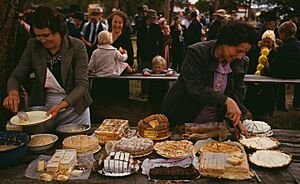
In the 20th century, many new people moved to New Mexico, bringing new skills and ideas. These included farmers, oilmen, people seeking healing in the dry air, artists, and scientists. Soldiers and airmen came for training at military bases. Scientists came to Los Alamos to build the atomic bomb. These new people brought money and helped modernize the state.
The State Supreme Court building, completed in 1937, was built during the Great Depression as a WPA project. These projects helped improve infrastructure and create jobs.
Women Get the Vote
The movement for women's right to vote worked hard in New Mexico. In 1920, New Mexico was one of the last states to approve the 19th Amendment, which gave women the right to vote. After this, more women, both Anglo and Hispanic, became involved in politics.
World War II and the Atomic Age
New Mexico had a high number of servicemen who died in World War II. The state also had many federal military bases. The war brought prosperity, jobs, and new skills to many young New Mexicans.
The top-secret Los Alamos Research Center was built in New Mexico's mountains in 1943. Its goal was to develop the world's first atomic bomb. The first atomic bomb was tested at Trinity Site in New Mexico on July 16, 1945, starting the atomic age. New Mexico became a major center for science.
After the war, Albuquerque grew rapidly. New Mexico became a leader in nuclear, solar, and geothermal energy research. The Sandia National Laboratories, founded in 1949, continued nuclear research.
Images for kids
-
Jean Nicolas Du Tralage and Vincenzo Coronelli's 1687 map of New Mexico
See also
 In Spanish: Historia de Nuevo México para niños
In Spanish: Historia de Nuevo México para niños



